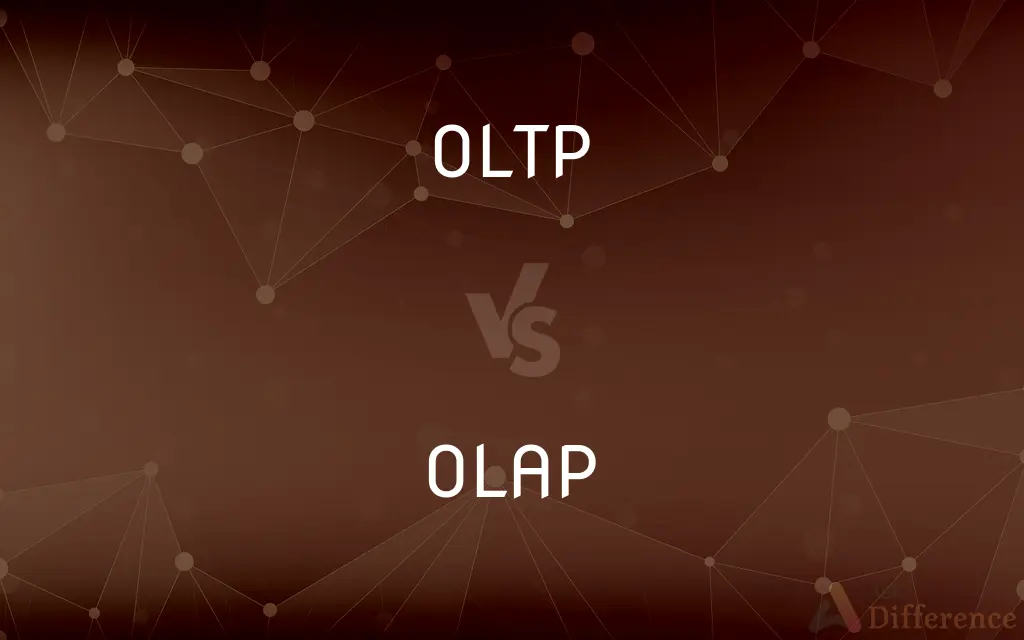OLTP vs. OLAP — What's the Difference?
By Tayyaba Rehman — Published on January 5, 2024
OLTP (Online Transaction Processing) supports transaction-oriented applications, while OLAP (Online Analytical Processing) supports complex analysis and queries.

Difference Between OLTP and OLAP
Table of Contents
ADVERTISEMENT
Key Differences
OLTP systems are designed to manage transactional data and are optimized for real-time business operations. They handle large numbers of simple read and write operations. OLAP systems, in contrast, are designed for analysis and are optimized for data retrieval operations. OLAP deals with complex queries to support decision-making processes.
OLTP databases are typically normalized to reduce data redundancy and ensure data integrity. This normalization is optimal for transactional speed and efficiency. OLAP databases often use denormalized data schemes, such as star or snowflake schemas, which are more suitable for quick retrieval of large amounts of data required for analysis.
The nature of transactions in OLTP systems is short and fast, allowing for immediate data entry and retrieval, which is essential for everyday business tasks like order processing, banking, and customer service. OLAP transactions are usually long and complex, involving aggregations and calculations across vast datasets, aiding in trend analysis, financial forecasting, and strategic planning.
In terms of database size, OLTP databases are generally smaller than OLAP databases. OLAP databases have to aggregate and store large volumes of historical data to enable trend analysis over time, which requires more storage space. OLTP systems focus on the current data necessary to execute transactions, not historical analysis.
The performance metrics for OLTP systems are often measured by the number of transactions per second, reflecting their operational nature. For OLAP systems, the key performance metric is the query response time, which reflects the system's analytical capabilities. Both systems are critical for businesses but serve different purposes.
ADVERTISEMENT
Comparison Chart
Main Focus
Managing daily transactions
Complex analysis and reporting
Data Structure
Normalized databases
Denormalized databases, often in star/snowflake schema
Query Types
Simple read and write operations
Complex queries involving aggregations
Database Size
Relatively smaller databases
Larger databases due to historical data storage
Performance Metric
Transactions per second
Query response time
Compare with Definitions
OLTP
OLTP supports real-time business operations.
The hotel reservation system relies on OLTP for immediate booking confirmations.
OLAP
OLAP allows complex analytical queries.
The marketing team performs customer segmentation using OLAP tools.
OLTP
OLTP systems use normalized data to ensure consistency.
Our OLTP-driven inventory system helps to prevent data redundancy.
OLAP
OLAP supports strategic business decisions.
We used OLAP to analyze sales trends over the last five years.
OLTP
OLTP handles large numbers of transactions.
The banking software uses OLTP to process millions of daily customer transactions.
OLAP
OLAP systems facilitate multidimensional analysis.
OLAP enables multi-faceted analysis of supply chain efficiency.
OLTP
OLTP is optimized for quick, routine tasks.
Their retail checkout system is built on an OLTP database for speed.
OLAP
OLAP is used for data mining and forecasting.
Financial analysts use OLAP to forecast quarterly revenue.
OLTP
OLTP databases are designed for operational efficiency.
OLTP systems ensure the integrity of our daily sales data.
OLAP
OLAP databases store large volumes of data.
Our OLAP database consolidates historical data from various departments.
Common Curiosities
What is OLTP?
OLTP stands for Online Transaction Processing, focusing on managing everyday transactions.
Can OLTP and OLAP be used together?
Yes, many businesses use both systems together, often integrating OLTP data into OLAP for analysis.
Are OLTP systems suitable for reporting?
OLTP systems can generate reports but are not optimized for complex analytical reporting like OLAP systems.
How often is data updated in an OLAP system?
Data in OLAP systems is updated periodically, not typically in real-time.
Is OLAP suitable for real-time processing?
OLAP is not typically designed for real-time processing; it's better suited for complex analysis.
What is an example of an OLAP operation?
An OLAP operation could be analyzing the purchasing patterns of customers over a certain period.
What is OLAP?
OLAP stands for Online Analytical Processing, which is used for data analysis and decision support.
How often is data updated in an OLTP system?
Data in OLTP systems is updated in real-time or near-real-time as transactions occur.
What type of database is used for OLAP?
OLAP uses analytical databases designed for complex queries and often includes data warehouses.
What type of database is used for OLTP?
OLTP systems use transactional databases optimized for quick operations.
What industries use OLAP systems?
Industries that require extensive data analysis, like finance, marketing, and healthcare, use OLAP systems.
What is an example of an OLTP operation?
An example of an OLTP operation is processing a customer's purchase at a checkout counter.
What industries use OLTP systems?
Industries like banking, retail, and e-commerce commonly use OLTP systems for daily transactions.
Can I use SQL with both OLTP and OLAP?
Yes, SQL can be used for querying both OLTP and OLAP systems, though the complexity of queries may differ.
Are OLTP and OLAP databases structured differently?
Yes, OLTP databases are typically normalized, whereas OLAP databases use denormalized schemas for faster querying.
Share Your Discovery

Previous Comparison
Vaguely vs. Vacantly
Next Comparison
IAS vs. IFRSAuthor Spotlight
Written by
Tayyaba RehmanTayyaba Rehman is a distinguished writer, currently serving as a primary contributor to askdifference.com. As a researcher in semantics and etymology, Tayyaba's passion for the complexity of languages and their distinctions has found a perfect home on the platform. Tayyaba delves into the intricacies of language, distinguishing between commonly confused words and phrases, thereby providing clarity for readers worldwide.
















































